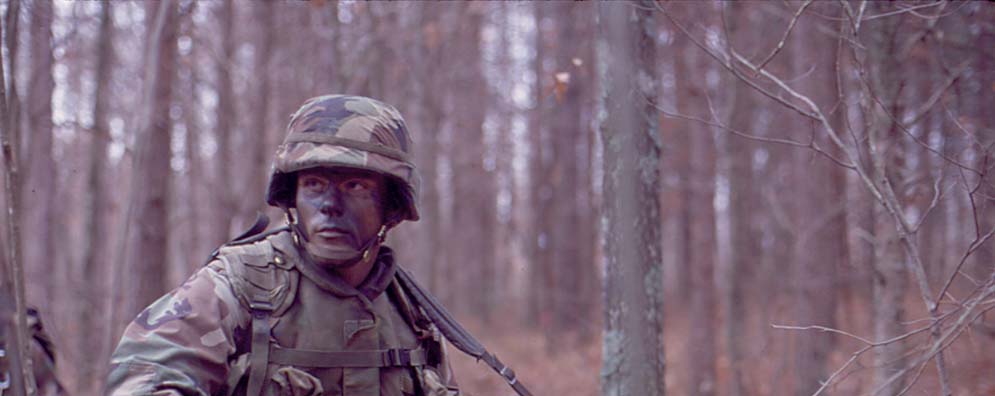By Robert Bruce
Today’s USMC Rifle Company is arguably the most lethal in Corps history. Packing a variety of weapons from the 9mm M9 pistol to the 83mm SMAW, its six officers and 176 enlisted men are well equipped to deal with a whole catalog of battlefield threats. The company’s three Rifle Platoons are armed with M16A2 assault rifles, M203 grenade launchers, and the compact, fast-firing M249 Squad Automatic Weapon, giving them a kill zone out to 600 meters or more. These combat proven weapons are relatively light, providing highly effective firepower to dismounted infantrymen whose best chance for survival and mission success is to move fast and hit hard.
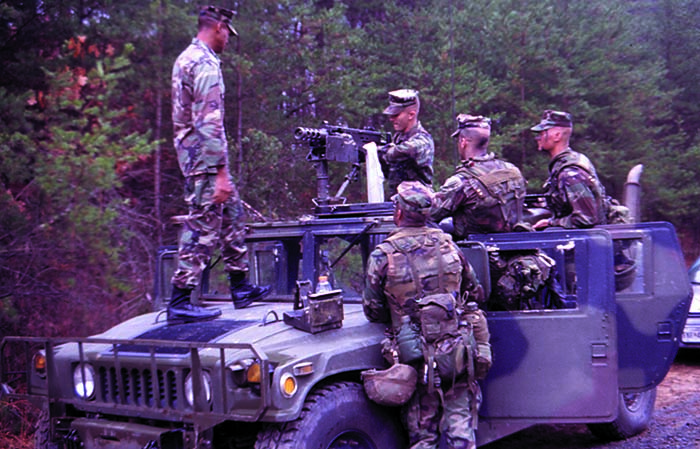
The student Weapons Platoon has been reinforced for the live fire exercise by two “Humm-Vees,” this one mounting a .50 caliber M2HB machine gun. The crew is in the process of installing the gun including its barrel and ammunition feed tray.
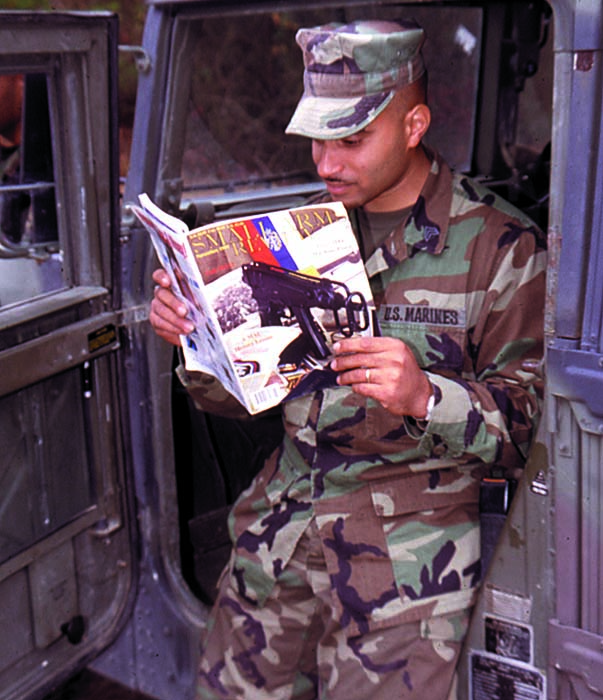
USMC Sergeant Jason Franco, driver of a TOW “Humm-Vee” assigned to support the Weapons Platoon Live Fire Exercise, takes a moment to look at SMALL ARMS REVIEW magazine.
Weapons Platoon
The big bite that “Devil Dog” grunts can deliver comes from their own Weapons Platoon; 47 Marines specially trained in the efficient employment of machine guns, mortars and rocket launchers. This interesting mix gives the company commander the ability to respond quickly and decisively to many of the challenges that are likely to be encountered in both offensive and defensive situations.
Usually under command of a 1st Lieutenant, the Weapons Platoon is organized into three sections with distinct but sometimes overlapping capabilities. First, the Machine Gun Section has Six M240G general purpose machine guns that can pump 7.62mm NATO rounds out to a maximum effective range of some 1800 meters with significantly more punch and sustained volume of fire than the 5.56mm SAW. The M240G is based on the highly respected Belgian MAG58, and replaces the fragile and trouble prone M60E3. Although somewhat heavier than the “Sixty”, the “Two-Forty Golf” is virtually indestructible and uncannily reliable under the worst conditions. These machine guns are particularly effective when fired from tripod mounts, dealing with enemy troops and light vehicles with both direct and indirect fire capability as the rifle platoons do their job. (See tech specs at end of article)
Then, the Mortar Section is home for three 60mm M224 light mortars. They put bigger and more effective high explosive, illumination, and smoke rounds way beyond the reach of those shoulder-fired 40mm M203 grenade launchers found in the rifle squads. These mortars are the company commander’s “hip pocket artillery”, immediately on call to wreak havoc day or night on enemy formations during offensive and defensive operations. (See tech specs at end of article)
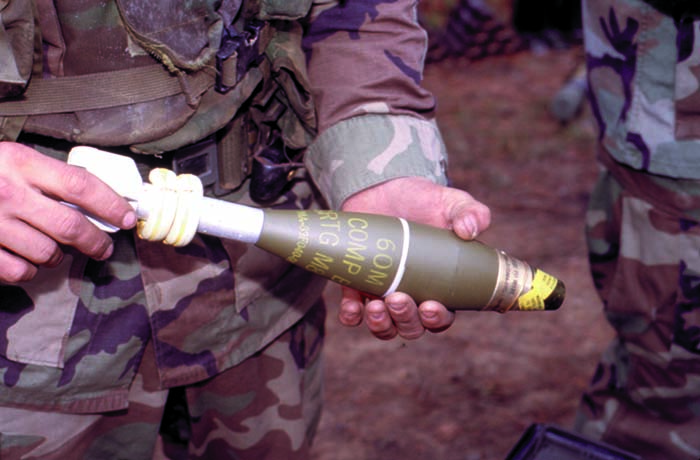
A close look at the complete 60mm HE (high explosive) round for the M224 Lightweight Mortar. Doughnut shaped things on the tailboom are propellant increments, capable of sending the round out to more than 3500 meters.
The Assault Section is the Weapons Platoon’s third element, with six MK153 Shoulder Launched Multipurpose Assault Weapons, usually called “SMAWs.” These awesome 83mm rocket launchers are direct-fire weapons that are capable of dealing with a variety of targets including armored fighting vehicles and earth/log bunkers. Also, supporting the increasing emphasis on fighting in urban areas, the SMAW is astonishingly effective even against reinforced concrete buildings. You wouldn’t want to be hiding behind a wall when the SMAW’s High Explosive Dual Purpose round slams into it, instantly turning your squad into unrecognizable pulp from blast and fragments. The assault section also provides demolitions support as required with bangalore torpedoes, satchel charges and mines. (See tech specs at end of article)
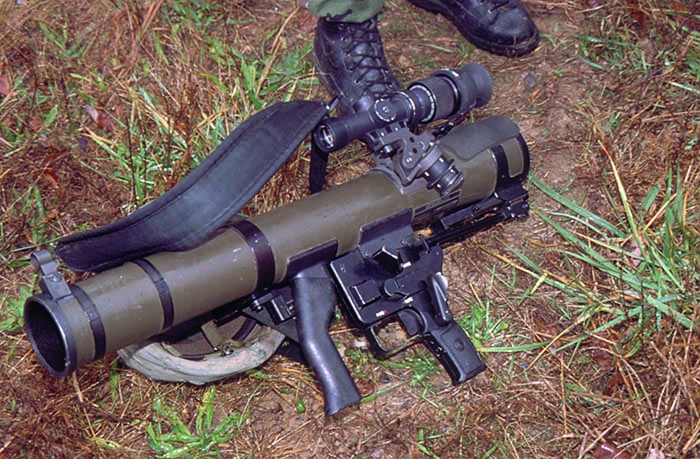
The Mk153 SMAW is a handy and powerful rocket launcher that collapses to only 29.9 in/75.95 cm for carrying. The SMAW’s rocket is enclosed in a separate tube that quickcouples to the launcher for firing.
Now, as fantastically capable as each of these heavy weapons can be, the company commander must employ them with skill and savvy to maximize their combined effect as a combat multiplier. While all of the factors that he must consider are way beyond the scope of this article, they obviously incorporate the basic triad of enemy, weather and terrain. Each of these must be taken into account as to how they will affect the desired outcome of either offensive (moving on the enemy) or defensive (luring him into your kill zone) operations with the least number of friendly casualties.
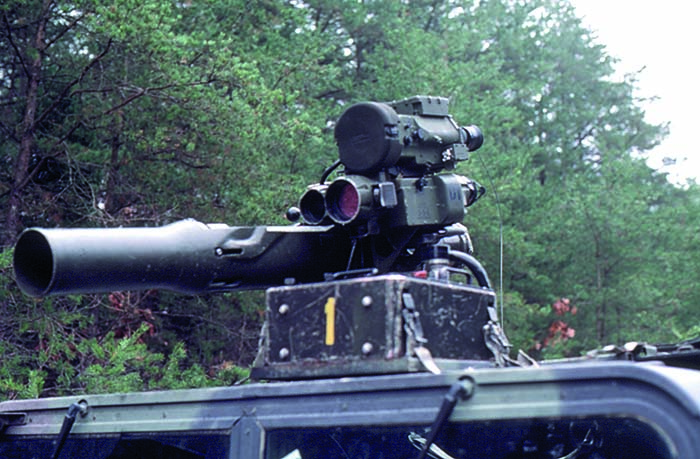
Another gun-model “Hummer” has been fitted with the highly effective TOW (Tube launched, Optically tacked, Wire guided) antitank system.
To this end, the commander relies to a large extent on advice from his Weapons Platoon commander — a very big responsibility for what is typically a lieutenant with only a year or two of real experience. How, then, does the Marine Corps ensure that this relatively green young man is equal to the job?
Infantry Officer Course
This challenge is met with a combination of formal schooling and on-the-job experience for a special breed of leader. While there is ample evidence that other components of the US Armed Forces are unevenly applying standards for officer selection and training in order to achieve social engineering “goals,” this doesn’t yet seem to be the case with the Marine Corps.
Always forward-deployed and with the strongest traditions of promotion based on merit and combat performance, the Corps remains committed to ensuring that its leaders are the best that America can provide. Marine officers, we are told, still get the kind of tough, uncompromising, and realistic training that keeps the Corps ready to fight anywhere in the world.
This is the responsibility of MCCDC, the Marine Corps Combat Development Command, located at the “Crossroads of the Corps” at Quantico, Virginia. There, newly-commissioned lieutenants who aspire to become infantry leaders jump from the frying pan of the Basic Officer Course to the fire of IOC; the Infantry Officer Course. This is an intense ten week full-immersion program of instruction in the theory and practice of bootborne combat.
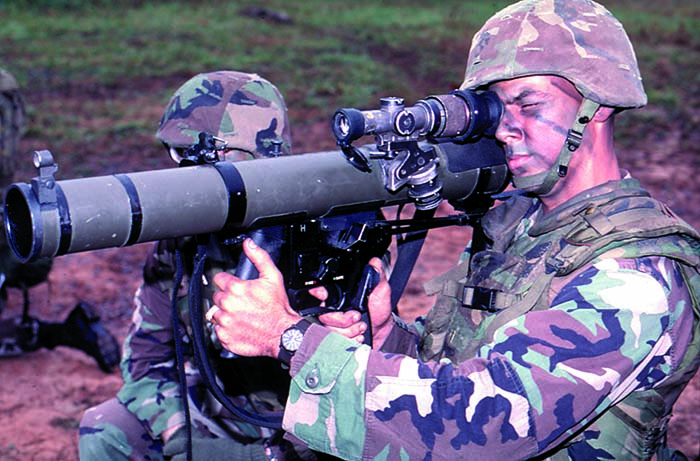
Corporal Mason keeps a careful eye on the lieutenants as they conduct a series of practice drills with the SMAW. Balance of the weapon is much better with the rocket in place.
At IOC these extraordinary young men have the opportunity to learn about and live fire most of the standard weapons of the Infantry Battalion from 9mm pistol to 81mm mortar. They also get thoroughly indoctrinated in the principles of offensive and defensive combat operations with and without support fire from tactical aircraft and artillery — including Naval gunfire. All along the way they have to consistently demonstrate that they have what it takes. This is measured through both individual performance and how they conduct themselves as student leaders in a multitude of tactical exercises and other situations – that they have what it takes. Yes, they are allowed to make mistakes, but only the ones who show that they have learned and corrected are allowed to continue.
According to Captain George Schreffler, IOC instructor, every lieutenant receives a solid grounding in infantry tactics while at the Basic Officer Course. This, in theory, prepares him to serve as a provisional rifle platoon commander if necessary. The staff at the BOC screens its graduates and assigns only about 35 out of a company of some 250 as infantry students.
“The grueling IOC program,” Schreffler says, “ensures that those without the necessary decision-making ability or physical attributes don’t graduate.”
This includes more than half of their 50 days in the field in all kinds of weather in a simulated combat environment. There are numerous tests of decision-making skills amid food and sleep deprivation, plus the physical strain from a series of long and challenging hikes.
Schreffler is quick to point out that, “Most graduates freely admit that IOC is the most physically and mentally difficult challenge they ever faced.”
Live Fire Exercise
One of many intense and demanding exercises at IOC is the Weapons Platoon Live Fire, typically scheduled near the end of the ten week course. MCCDC course materials state the purpose of this is “to successfully employ all crew-served weapons assets of the Marine Rifle Company in accordance with a ground scheme of maneuver.” While this may seem a straightforward tasking to the casual observer, there is a lot that goes into it.
First, there is the need to translate a formal Operations Order into a plan for both maneuver and fire support and to ensure that all players know what their responsibilities are. Then, the platoon must successfully move by both Amphibious Armored Assault Vehicle and by foot to take up planned positions on unfamiliar terrain. Finally, the various weapons must be fired on schedule and on targets both anticipated and unanticipated. Oh, by the way, there may be a few surprises here and there, courtesy of the IOC cadre….
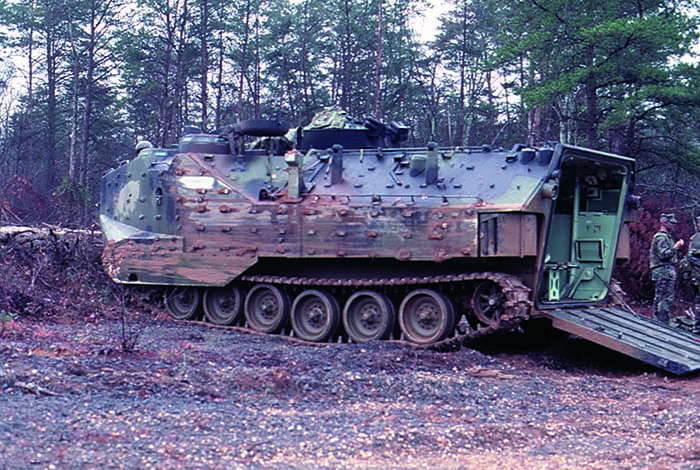
Four AAVP-7A1s are lined up, ready to carry each section of the Weapons Platoon on their first leg of movement toward firing positions. Their massive tailgates are down and roof panels open as crewmen hurry about the tasks necessary to mount heavy weapons and make other preparations for combat. 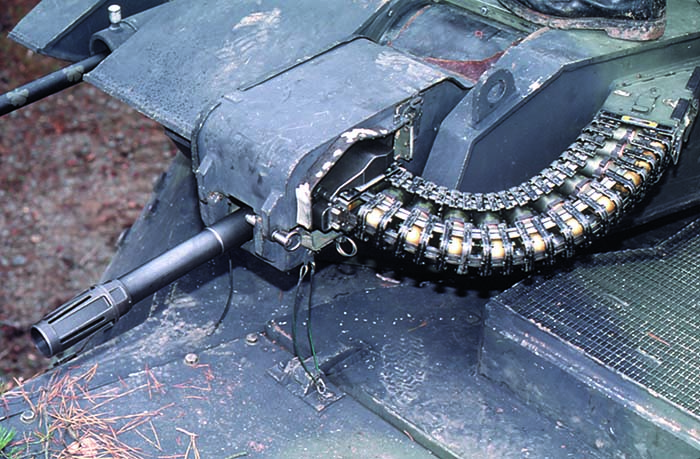
The high powered 40mm grenade for the Mark 19 is quite different from that of the hand-held M203 launcher, developing considerably more chamber pressure, recoil and range. Its linked rounds travel from inside the turret to the gun through a flexible feed chute that, if necessary, can be shielded from environmental conditions by a protective fabric cover. 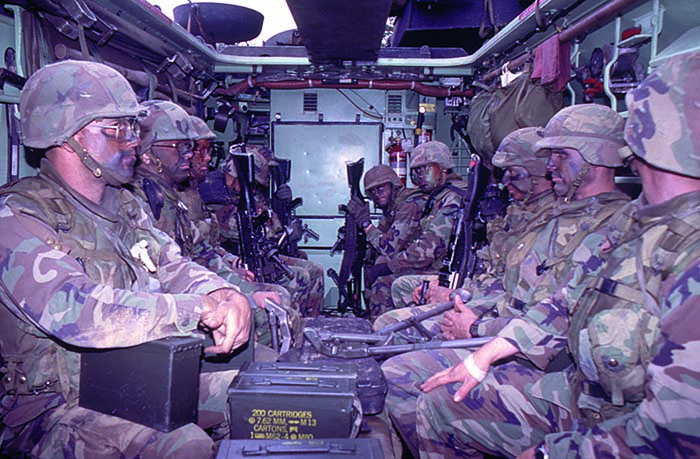
The order to mount up finally comes and the Machine Gun Section climbs aboard the AAVP for a short and bumpy ride. They point the guns muzzle down in accordance with safety and operational procedures developed from combat experience.
With student lieutenants in all roles from weapons crewmen to platoon commander, the possibilities for both comedy and tragedy are seemingly endless.
I arrived on Quantico’s Range 6 on the morning of 23 Nov, as the Marine lieutenants of IOC Classs #1-100 prepared for the first of two full scale runs of the Live Fire exercise. The Battalion Commander’s Operations Order had already been given to the student acting as Weapons Platoon Commander and all of the various sections were busy with rehearsals and other preparations.
The canned Operations Order used for this exercise is plausibly based on real-life possibilities with a tactical scenario involving hostile forces in Bosnia. The mission of Fox Company’s Weapons Platoon is to move undetected into suitable positions then put fifteen minutes of suppressive fire on an enemy howitzer battery and the motorized rifle platoon that is protecting it. Properly executed, this will cover two of Fox Co.’s rifle platoons as they flank and assault the enemy positions, clearing the way for fast movement of follow-on forces.
For rehearsal purposes and later during actual movement and firing, each section was under direct supervision of a Marine non-commissioned officer who was an expert in tactical employment of that weapon. From what I observed, these corporals and sergeants were very professional and matter-of-fact with the lieutenants, providing lessons not only in how to use the weapons, but also how to interact with enlisted men whose experience and knowledge are always essential to mission success.
Meanwhile, support personnel were also busy with many tasks necessary to make the exercise work despite competing necessities of both safety and realism. This included an amazing variety of items from toilet paper to TOW missiles, with stacks of ammunition, several different tactical radios, and four big, hulking AAVP-7 (Assault Amphibian Vehicle Personnel) tracked vehicles.
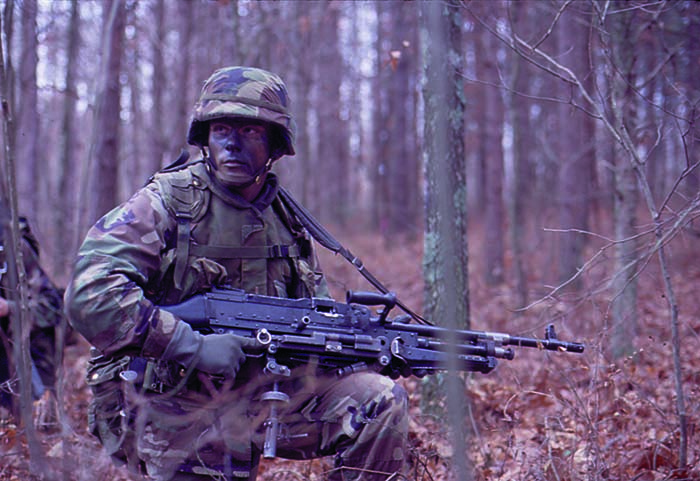
Pausing for a moment while leaders check their maps, this M240G gunner and the rest of his section keeps a lookout for any sign of enemy presence. 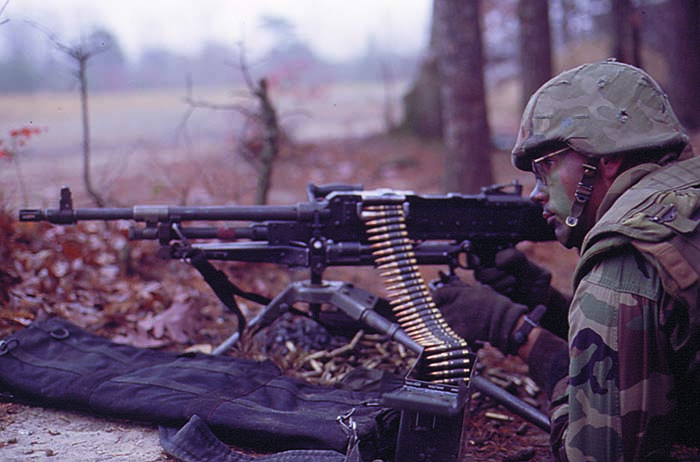
“H-Hour” (time to begin firing as required in the Operations Order) arrives with a chattering clamor as the M240G’s begin to shoot. The guns have only about 1200 rounds each and this has to last most of the 15 minutes required by the Battalion Commander’s Operations Order. Simple math calculations show that they must pace their fire to a slow but sustained rate of about 100 rounds per minute with only two guns firing at a time. 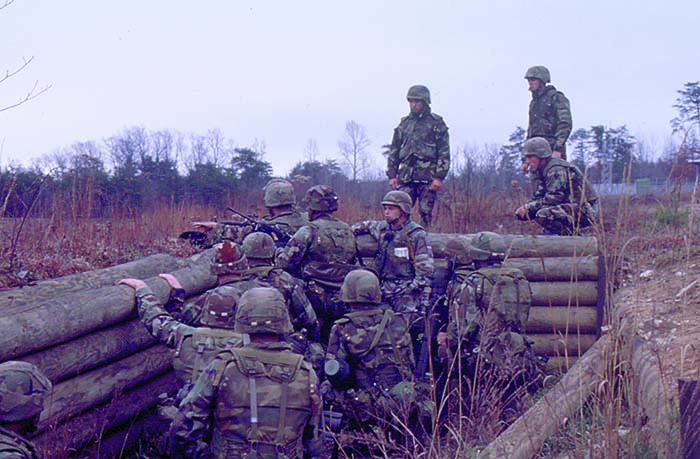
Delayed by mine-clearing duties, the Assault Section arrives at a fast run but a bit late. The section crowds into the relative safety of a log crib some 50 meters to the left and slightly forward of the Machine Gun Section’s positions. 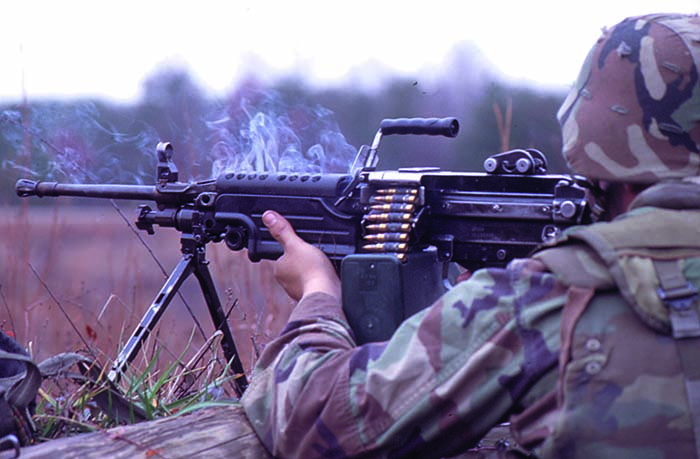
Two M249 SAWs are attached to the Assault Section and they are brought almost immediately into action as a supplement to the methodical fire from the bigger “Two-Forty Golfs.” However, their effectiveness is hampered by the physics of the small 5.56mm round and geometry of firing from a bipod mount. These are significant factors since the intended target area is at the far limit of the M249’s maximum effective range. Ripping away long bursts at a cyclic rate of some 725 rpm, it doesn’t take long before the SAW barrels are smokin’!
Also, in addition to the standard crew-served arms found in the Weapons Platoon, exercise play would include some interesting assets from the Infantry Battalion’s Weapons Company. The student platoon commander would be able to call on support fire from 81mm mortars and 105mm howitzers, as well as a pair of tough and squat “Humm-Vees,” one mounting a TOW antiarmor missile, and the other a .50 caliber heavy machine gun. All of these, by the way, were crewed by experienced Marine enlisted men from the MCCDC’s Weapons Platoon, Combat Instructor Company, Instructor Battalion, The Basic School.
Had the weather cooperated the exercise would also have the dramatic advantage of close air support. This usually comes in the form of fast movers like the F/A-18 HORNET and the AV-8 HARRIER, or from attack helicopters. Now, before anybody gets upset that poor visibility kept the air support on the ground, let it be said that rules of combat are much different from rules of peacetime training. It doesn’t make sense to take a chance of crashing good aircraft and killing good pilots for a fairly routine ground training exercise.
“Move Out!”
By early afternoon everything seemed to be in order and the students loaded up into the AAVP-7s for the first phase of movement. These remarkable amphibious tracked vehicles serve as battle taxis, capable of delivering up to 18 Marine infantrymen in full gear from a seaborne assault ship to even miles inland if required. Although awkward and slow moving, they have a lethal sting in the form of an armored turret mounted with two belt-fed machine guns, one a .50 cal. M2 and the other a 40mm Mk19. (See tech specs)
The 60mm mortar section was the first group to disembark along the route of motor march. This allows them time to set up and be ready to provide indirect fire support from a position well hidden from enemy observation and protected from counterbattery fire.
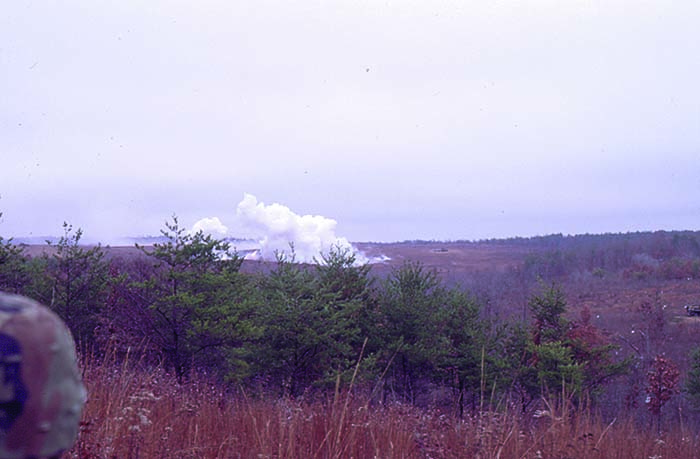
As bad as it must be for the enemy already, things get considerably worse when an 81mm mortar coughs to life. This big bore weapon is on loan from the Battalion as a supplement to the organic firepower of the Weapons Platoon. The big mortar is firing “Willie Pete” — white phosphorous rounds — which have a dramatically different impact signature than 60mm HE. Each round bursts with a giant cloud of white smoke and showers the area with fiercely burning chunks.
AAVs make a lot of noise from both their diesel engines and the characteristic metallic squeal of most fully tracked vehicles. This meant that a few hundred meters further up the rough and narrow trail the machine gun and assault sections also had to jump out in order to be outside hearing range of the enemy’s presumed forward observation posts. Stealthy movement on foot of the men and their heavy burden of weapons and ammunition was required from here on as they put into practice many hours spent on land navigation and other infantry skills.
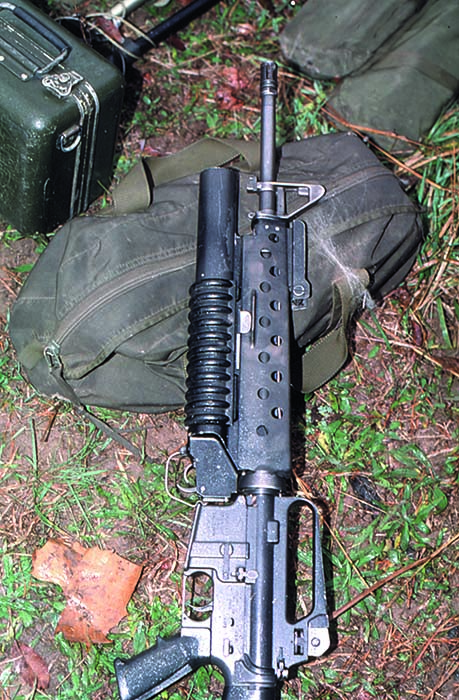
A 5.56mm M16A2 assault rifle equipped with 40mm M203 grenade launchers. This handy and lethal combination has been standard in Marine Rifle Squads since the Vietnam War.
A bit of a surprise was in order as the platoon’s forward elements neared their predetermined fire positions. The “enemy” had placed a cluster of antitank mines right in the path the AAVs were supposed to take. Fortunately, the assault section had run several practice drills with just this in mind, and soon cleared the way. Unfortunately, as was embarrassingly pointed out later in the after action review, there was little thought given to providing the mine clearing team with covering fire just in case the mine field was sniper’s bait. This, the instructors often say, is “how we learn….”
Meanwhile, as the countermine efforts were still underway, the machine gun section was literally crawling up a gentle incline in the treeline to ensure they were in position and ready to shoot at H Hour. This protected them from enemy observation and put them into an excellent spot allowing unobstructed direct fire on a cluster of derelict target tanks. Situated some 800 meters away, deep in the enormous impact area of Range 7, these tanks represent BTR-60 wheeled armored cars of the enemy motorized rifle platoon as identified in the Operations Order.
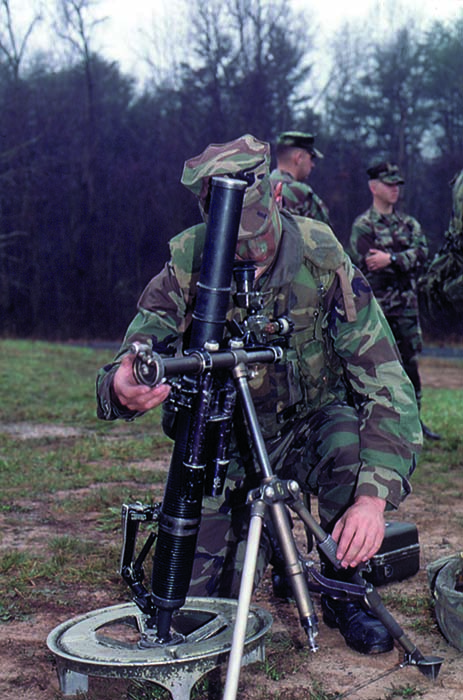
The M224 mortar is an indirect fire weapon, meaning that the round is fired in a high arc at long range, then drops down on an intended target that is usually unseen by the crew. The optical sight is used to align the bore of the weapon with a fixed aiming point nearby — ideally these red and white striped aiming stakes. Corrections in actual impact of the rounds are made by a Forward Observer (FO) and relayed to the crew in the form of horizontal and vertical changes to settings on the sight. This is a complex geometrical process requiring a lot of training of all involved.
Learning Curve
If things had gone exactly according to plan then all weapons would have been in place and simultaneously firing at the appointed time. As it happened, the M240 machine guns started right on schedule but there was a noticeable lag before the mortars began kicking in. Finally, the assault section, reinforced by a pair of M249 SAW’s to represent fire from two attached rifle squads, got into their position in a log crib to the left of the machine gunners, adding more noise and smoke to the “fog of war.” A note to armchair generals — this stuff isn’t easy to do, particularly when the Marine grunts are all new 2nd Lieutenants.
Ah, but when everything started popping away it was a sight to behold. The spacious impact area was crisscrossed with red laserlike tracers from the SAWs and the medium machine guns. Soon, plumes of smoke began to arise nearby on the grid coordinates occupied by the imaginary enemy artillery battery. These marked the impact of high explosive 60mm and 81mm mortar rounds, marched in by a student in the role of Forward Observer.
Exercise controllers soon added a bit more spice to the tactical play, directing the assault section leader to engage with DRAGON and SMAW a trio of target tanks with the closest two about 350 meters out and another approximately 500 meters away. The rocket teams jumped up from the protection of the log crib and scrambled to get into position. Despite their inexperience, it wasn’t long before three antiarmor weapons were ready. One SMAW was first to fire, rapidly popping off several 9mm spotter-tracer rounds until the gunner was sure of his sight picture. This was followed by a deafening blast and flying debris as the big antitank rocket left its launcher and streaked downrange, getting a near miss on the closest enemy armored fighting vehicle. The second SMAW finished the job, scoring a good center of mass hit.
The DRAGON gunner was taking his time, but when he finally hit the trigger bar his guided missile launcher erupted with similar earplug-packing blast and smoke. If there had been any actual bad guys downrange they damn sure knew from the launch signature exactly where these rockets were coming from!
Unlike the point and shoot/fire and forget SMAW, DRAGON is a a wire guided missile that the gunner “flies” to its target by keeping it squarely in crosshairs in his fire control system. Theoretically, this gives the DRAGON the capability of hitting even a fast moving tank. Alas, the missile ran out of wire before it got to its tank and promptly took a nose dive into the dirt. There is an important correlation between maximum range of the weapon and actual range to the target. “This is how we learn.”
By now the AAVs had driven up the free-of-mines trail, their noise of movement screened by the rude concert from multiple weapons. Coming on line, they quickly added to the excitement by pumping .50 caliber slugs and 40mm grenades into the ridgeline occupied by the luckless enemy BTRs. The Mark 19 grenade chucker is an excellent compliment to both the .50 cal and 7.62mm machine guns, literally carpeting the target area with high explosive bomblets. This weapon’s inherent long range effectiveness is particularly enhanced by the sturdy turret mount of the AAV and its highly precise ballistic computing optical sight.
To any enemy the required fifteen minutes of suppressive fire called for in the Operations Order would have been an eternity in Hell of fire and steel. However, as several of the Marine lieutenants later remarked, things on their end seemed to go remarkably fast. This was particularly true for the four M240G machine gunners, who had to make do with a relatively paltry 1200 rounds each and all ran out of ammo before running out of time.
Lessons Learned
As the last rounds were heading downrange the Weapons Platoon pulled back from the firing line to an established rendezvous point. If this had been an actual combat operation, they would then have jumped back into their AAVs and moved out to rejoin the rest of Fox Company, helping to consolidate the Battalion’s objective. But, since this was only a practical exercise, (and the impact area “objective” was full of lethal duds from countless years of firing) the next order of business was to gather around for a quick AAR — After Action Review.
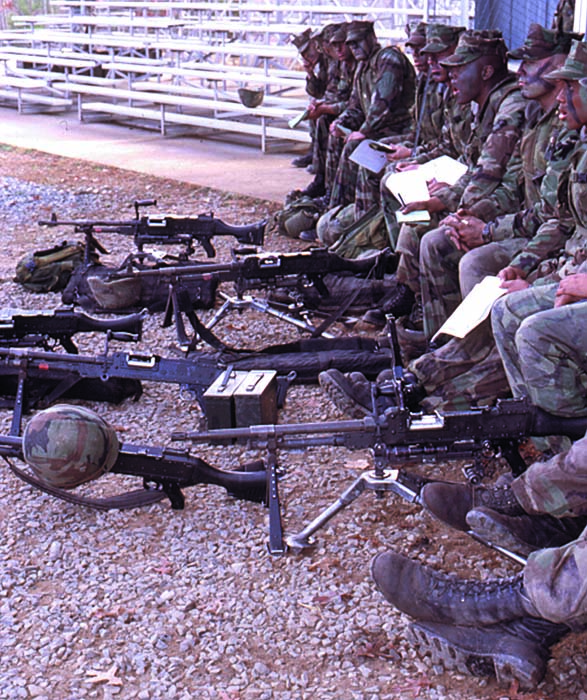
Captain Mike Targos, Range Officer, adds his comments to the big After Action Review taking place in the bleachers on Range 7 as all of the Marines involved — students and support personnel — gather to critique the operation.
This is the time for a no-bullshit examination of what went right and what went wrong. All participants are encouraged and expected to contribute with students, exercise controllers, safety officers, and weapons NCOs being as candid as possible. This is, after all, a much better way to learn without the unpleasant side effects of being — or causing others to be — wounded or killed.
It has been said that the making of a U.S. Marine Infantry Officer is an inexact science but one with which the Corps has a long history and much demonstrated success. Let us hope and pray that the way it is being done now at Quantico is the best way and will continue to forge the best America has to offer into technically and tactically proficient leaders with no compromises in standards.
Let all Americans of good conscience also demand that our elected representatives promptly and decisively reverse years of the Clinton administration’s politically calculated starvation, neglect and ill-concealed contempt for the Armed Forces. It is long past time for congress to reverse the dangerous slide in readiness and morale by restoring realistic funding levels and allowing a return to common sense rules for training and deploying the men and women soldiers, sailors, airmen and marines who keep America’s many enemies at bay.
| This article first appeared in Small Arms Review V4N2 (November 2000) |



